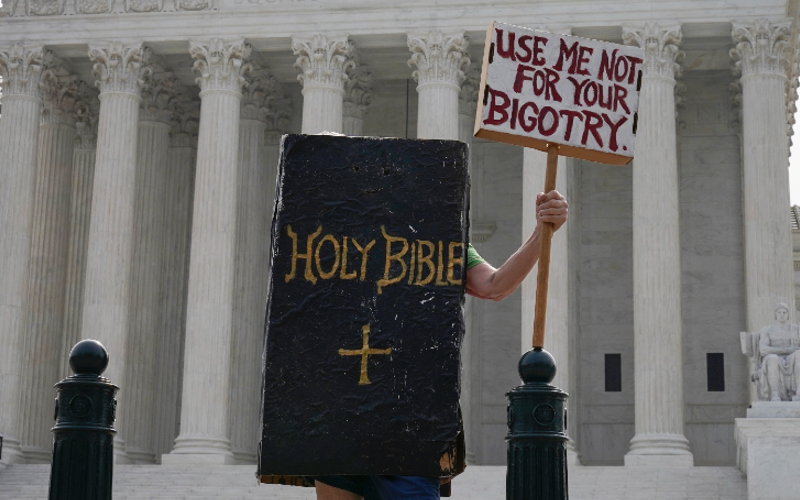The question before the justices in Moore v. Harper was whether North Carolina’s state supreme court overstepped its bounds in striking down a Republican-drawn map that it said would have given the GOP control in too many of the state’s 14 districts.
Republicans challenged the state court’s ruling and asked for the Supreme Court’s interpretation of Article I, Section 4 of the Constitution, which gives state legislatures near exclusive authority over the “times, places and manner” of holding elections for senators and representatives.
The Constitution drifts from state authority only to say that “Congress may at any time by law make or alter such regulations,” but even then Congressional authority in states’ handling of elections is limited. Article I, Section 4 says Congress can step in only as it relates to “the places of choosing Senators.”
No wording in the Constitution gives state courts the ability to override state legislatures in this matter.
However, six Supreme Court justices voted in favor of broader interpretation.
“It’s not a great opinion,” John Hostettler said on American Family Radio last week. The Constitution “does vest exclusive authority in the state legislatures to draw maps.”
Every 10 years states redraw the maps for their congressional districts based on changing population counts from the U.S. Census.
After the state supreme court blocked the legislature’s map in 2022, it accepted a map drawn by three former judges. That map was good for only the 2022 mid-term elections, so redistricting is back on the table in North Carolina.
Hostettler told show host Jenna Ellis, herself an attorney, that the Constitution’s Supremacy Clause was conspicuous by its absence in the Supreme Court’s decision.
“Most troubling to me, but not completely unfamiliar, is what the federal judiciary left out of its opinion, and that is any reference to the Supremacy Clause, which is in Article VI," he observed. "Article VI solves this problem. It answers the question that the court ostensibly is asking: Do the state legislatures have exclusive authority? If you look at Article I, Section 4 the answer is yes.”
Court ignores Supremacy Clause
The Supremacy Clause establishes that the Constitution, federal laws made pursuant to it and treaties made under its authority equate to the “supreme law of the land” and overrule any conflicting state laws.
It’s what was missing from the Articles of Confederation, which gave more power to the states, and what now gives more power to the federal government.
“Can the sate courts intervene, or in my opinion interfere, in this exclusively vested authority in the constitution? The Supremacy Clause very clearly answers this question. This Constitution and the laws of the United States, which shall be made in pursuance thereof and all treaties made or which shall be made under the authority of the United States … shall be the supreme law of the land,” Hostettler said.
It’s not just laws for the people. It also applies to state supreme court justices who exceeded their authority but benefited from a flawed ruling by the court above them.
“The judges in every state shall be bound by the Constitution," Hostettler further explained. "In this case, the Court is basically being asked, ‘Does the North Carolina state legislature have exclusive jurisdiction?’ Article I, Section 4 answers that. Can the judges disregard that particular exclusive authority? The Constitution clearly says no.”
Mainstream media described the North Carolina Republicans’ attachment to Article I, Section 4 as “obscure,” making the argument that a different ruling from the Supreme Court
Former president Barack Obama said the Supreme Court “rejected the fringe independent state legislature theory that threatened to upend our democracy.”
Writing for the majority, Chief Justice John Roberts cited Marbury v. Madison, the landmark case in 1801 that established judicial review which is the right of the Supreme Court to determine the constitutionality of the actions of the other two branches of government.
“Roberts, in my opinion, is a little tone deaf when he cites the same case, the same precedent, if you will, that every other court has cited before this time when they seek to interfere,” Hostettler said.
Hearing a settled case brings Court into question
Hostettler said the justices, in reading the Constitution, put a period where they should have put a comma.
“It’s my observation that the Supreme Court wanted a particular outcome. They wanted to assume more authority over state legislatures in the drawing of congressional maps. They had their outcome, and they drafted an opinion to suit that outcome.”
The desired outcome made it necessary to ignore the Supremacy Clause.
“It would have dispelled any notion that the courts could do anything in this matter. This is just something that the framers knew was a possibility. Thomas Jefferson railed against the potential authority that a life-tenured federal judiciary could assume to themselves,” Hostettler said.
In the dissenting viewpoint, Justice Clarence Thomas wrote that the Supreme Court’s purpose is to “resolve not questions and issues but cases or controversies.”
Thomas was opposed to Moore v. Harper being heard by the Court.
When a case has been decided, but is considered by the Court anyway, the Court’s motivations come under scrutiny.
“We can read the Constitution ourselves. We can read this opinion, and we can say, ‘Well wait, this part is completely contrary to the Constitution,’” Hostettler said. “So they’re trying to assume more authority, and we need to stop that.”
Some have suggested that Marbury v. Madison needs to be reinterpreted, and Hostettler agrees.
There were twisting winds around the Supreme Court at the turn of the 19th century – such as the impeachment of Justice Samuel Chase – that helped it arrive at the Marbury v. Madison decision, he said.
“For the next 32 years the Supreme Court never again overturned a congressional act,” Hostettler said.







